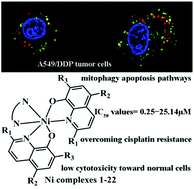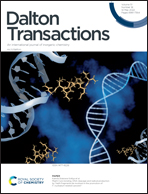A new class of nickel(ii) oxyquinoline–bipyridine complexes as potent anticancer agents induces apoptosis and autophagy in A549/DDP tumor cells through mitophagy pathways†
Abstract
A new class of nickel(II) oxyquinoline–bipyridine complexes, namely, [Ni(La1)2(Lb6)] (Ni1), [Ni(La1)2(Lb2)] ·CH3OH (Ni2), [Ni(La7)2(Lb11)]·2H2O (Ni3), [Ni(La1)2(Lb9)] (Ni4), [Ni(La1)2(Lb8)] (Ni5), [Ni(La2)2(Lb1)] (Ni6), [Ni(La2)2(Lb6)]·CH3OH (Ni7), [Ni(La2)2(Lb11)]·CH3OH (Ni8), [Ni(La2)2(Lb3)] (Ni9), [Ni(La2)2(Lb2)]·CH3OH (Ni10), [Ni(La2)2(Lb5)]·CH3OH (Ni11), [Ni(La2)2(Lb7)] (Ni12), [Ni(La3)2(Lb2)] (Ni13), [Ni(La4)2(Lb4)]·2CH3OH (Ni14), [Ni(La4)2(Lb8)]·2.5CH3OH (Ni15), [Ni(La4)2(Lb11)]·1.5CH3OH (Ni16), [Ni(La5)2(Lb7)] (Ni17), [Ni(La5)2(Lb10)]·CH3OH (Ni18), [Ni(La6)2(Lb11)]·3CH3OH (Ni19), [Ni(La7)2(Lb7)]·2CH3OH (Ni20), [Ni(La7)2(Lb8)]·2CH3OH (Ni21) and [Ni(La7)2(Lb1)]·2CH3OH (Ni22) bearing oxyquinoline (H-La1–H-La7) and bipyridine derivatives (Lb1–Lb11) were synthesized and characterized by elemental analysis, X-ray crystallography, infrared (IR) spectroscopy and electrospray mass spectrometry (ESI-MS). An MTT method suggested that the IC50 values of Ni1–Ni22 for A549/DDP tumor cells were 0.25–25.14 μM, but these complexes exhibited low cytotoxicity toward normal HL-7702 cells (>50 μM). Ni2 could induce A549/DDP tumor cell apoptosis, cause a decrease in the mitochondrial membrane potential (MMP, ΔΨm), and increase the intracellular [Ca2+] and reactive oxygen species (ROS) levels better than Ni10, Ni13, and Ni14. Autophagic and western blot assays showed that Ni2, Ni10, Ni13, and Ni14 could induce autophagy and regulate the expression of LC3 II/I, Beclin1, P62, PINK1, and Parkin proteins, and the inducibility activities were in the order of Ni2 > Ni14 > Ni13 > Ni10. Taken together, these results revealed that the nickel(II) oxyquinoline–bipyridine complex Ni2 inhibited cell growth in A549/DDP tumor cells via mitophagy pathways.



 Please wait while we load your content...
Please wait while we load your content...